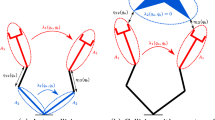Abstract
This work performs an experimental study on the legibility of paths executed by a manipulation arm available on a Baxter robot. In this context, legibility is defined as the ability of people to effectively predict the target of the arm’s motion. Paths that are legible can improve the collaboration of robots with humans since they allow people to intuitively understand the robot’s intentions. Each experimental trial in this study reproduces manipulator motions to one of many targets in front of the robot. An appropriate experimental setup was developed in order to collect the responses of people in terms of the perceived robot’s target during the execution of a trajectory by Baxter. The objective of the experimental setup was to minimize the cognitive load of the human subjects during the collection of data. The extensive experimental data provide insights into the features of motion that make certain paths more legible for humans than other paths. For instance, motions where the end-effector is oriented towards the intended target appear to be better in terms of legibility than alternatives.
Access this chapter
Tax calculation will be finalised at checkout
Purchases are for personal use only
Similar content being viewed by others
References
Rethink Robotics: Baxter Research Robot Software Development Kit (SDK) Version 0.7.0 (2013)
Gielniak, M., Thomaz, A.: Generating anticipation in robot motion. In: IEEE RO-MAN, pp. 449–454 (2011)
Beetz, M., Stulp, F., Esden-Tempski, P., Fedrizzi, A., Klank, U., Kresse, I., Maldonado, A., Ruiz, F.: Generality and legibility in mobile manipulation. Auton. Robot. 28(1), 21–44 (2010)
Gielniak, M.J.: Spatiotemporal correspondence as a metric for human-like robot motion. In: In ACM/IEEE HRI (2011)
Argall, B.D., Chernova, S., Veloso, M., Browning, B.: A survey of robot learning from demonstration. Robot. Auton. Syst. 57(5), 469–483 (2009)
Billard, A., Calinon, S., Dillmann, R., Schaal, S.: Robot programming by demonstration. In: Siciliano, B., Khatib, O. (eds.) Springer Handbook of Robotics, pp. 1371–1394. Springer, Berlin (2008)
Dragan, A.D., Lee, K.T., Srinivasa, S.S.: Legibility and predictability of robot motion. In: International Conference on Human-Robot Interaction (HRI) (2013)
Dragan, A., Srinivasa, S.S.: Generating legible motion. In: Proceedings of Robotics: Science and Systems, Berlin, Germany (2013)
Dragan, A., Srinivasa, S.S.: Familiarization to robot motion. In: International Conference on Human-Robot Interaction (HRI) (2014)
Momasello, M., Carpenter, M., Call, J., Behne, T., Moll, H.: Understanding and sharing intentions: the origins of cultural cognition. In: Behavioral and Brain Science (2005)
Csibra, G., Gergely, G.: Obsessed with goals: functions and mechanisims of teleological interpretation of action in humans. Acta Psychol. 1(124), 60–78 (2007)
Woodward, A.L.: Infants selectively encode the goal object of an actor’s reach. In: Cognition (1998)
Woodward, A.L., Guajardo, J.J.: Infants’ understanding of the point gesture as an object-directed action. In: Cognitive Development (2002)
Kimmel, A., Dobson, A., Littlefield, Z., Krontiris, A., Marble, J., Bekris, K.E.: Pracsys: an extensible architecture for composing motion controllers and planners. In: Simulation, Modeling and Programming for Autonomous Robots (SIMPAR), Tsukuba, Japan (2012)
Marble, J., Bekris, K.E.: Asymptotically near-optimal is good enough for motion planning. In: Proceedings of the 15th International Symposium on Robotics Research (ISRR-11), Flagstaff, AZ 28 Aug–1 Sept 2011
Kavraki, L.E., Svestka, P., Latombe, J.C., Overmars, M.: Probabilistic roadmaps for path planning in high-dimensional configuration spaces. IEEE TRA 12(4), 566–580 (1996)
Şucan, I.A., Moll, M., Kavraki, L.E.: The open motion planning library. IEEE Rob. Autom. Mag. 19(4), 72–82 (2012). http://ompl.kavrakilab.org
MATLAB: version 8.2.0.701 (R2013b). The MathWorks Inc., Natick, MA (2013)
Sucan, I.A., Chitta, S.: Moveit! Online
Smits, R.: KDL: kinematics and dynamics library. http://www.orocos.org/kdl
Author information
Authors and Affiliations
Corresponding author
Editor information
Editors and Affiliations
Rights and permissions
Copyright information
© 2016 Springer International Publishing Switzerland
About this chapter
Cite this chapter
Zhao, M., Shome, R., Yochelson, I., Bekris, K., Kowler, E. (2016). An Experimental Study for Identifying Features of Legible Manipulator Paths. In: Hsieh, M., Khatib, O., Kumar, V. (eds) Experimental Robotics. Springer Tracts in Advanced Robotics, vol 109. Springer, Cham. https://doi.org/10.1007/978-3-319-23778-7_42
Download citation
DOI: https://doi.org/10.1007/978-3-319-23778-7_42
Published:
Publisher Name: Springer, Cham
Print ISBN: 978-3-319-23777-0
Online ISBN: 978-3-319-23778-7
eBook Packages: EngineeringEngineering (R0)




